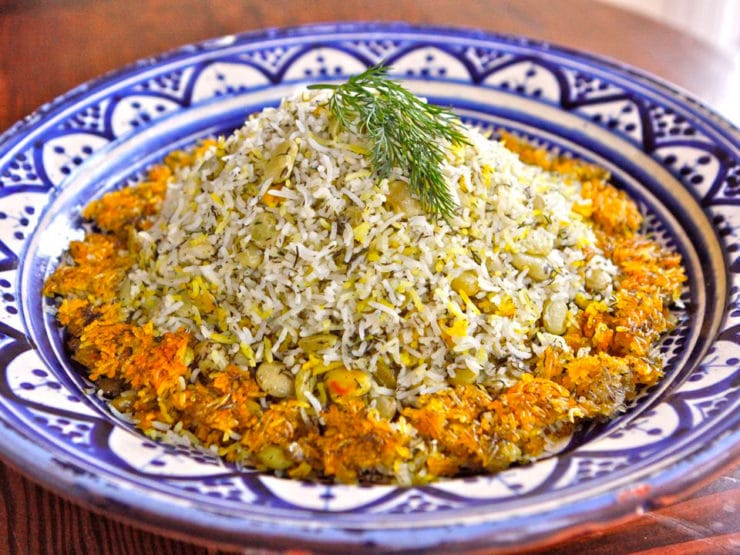
Iran has a rich culinary history, and rice resides at the heart of the Persian cooking tradition. Rice was likely introduced to Iran from India during the rule of Darius the Great in the 6th century BCE. Over time it became a staple food item for Iranians, cultivated in many sophisticated varieties. A multitude of flavorful and fragrant rice dishes have emerged throughout the centuries… saffron-scented rice, cooked with herbs and tender meats; sweet rice with dried fruits or sour cherries; vegetable rice, sometimes mixed with legumes… and for the ancient royal courts, there was even rice studded with jewels.
Over time, four methods have developed for preparing Persian rice: kateh, damy, chelow, and polo. Kateh is simply rice steamed with water, salt, oil or butter, and sometimes saffron. Damy is rice steamed more slowly and mixed with uncooked ingredients, like beans or grains. Chelow is parboiled rice mixed with seasonings and/or herbs, then slowly steamed to form a crispy tahdig (sometimes spelled tahdeeg). Polo (or polow) is a variant of chelow in which aromatic ingredients like meat, fruit, and/or vegetables are mixed into the rice. Polo rice dishes are popular for their complex, mouthwatering flavor combinations.
Which brings me to today’s recipe: Persian Dill and Lima Bean Rice. This is my favorite Persian dish, and I’ve spent the past two years looking for the perfect recipe. The original version of this dish, Baghali Polo, is most often made with young, fresh fava beans. The version I’ve grown to love is made with lima beans, but you can also use fresh young fava beans if you wish. I wanted a non-dairy version for my kosher readers; Persian cooks sometimes use butter or ghee and yogurt in their rice, but Jewish cooks prefer to make it dairy-free so it can be served with a kosher meat meal. I tried many versions from various Persian and Sephardic Jewish cookbooks, but I was never completely satisfied with the results. Then I had my Persian Jewish friend Farah teach me her way of making it. Over time, I was able to combine the methods I’d learned to develop a terrific recipe. The most challenging part was figuring out how to create a crispy, golden tahdig.
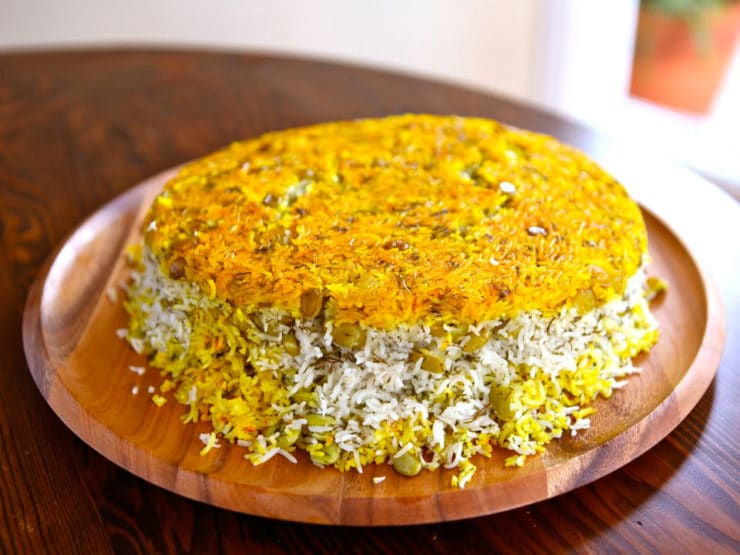
The word tahdig is Persian, meaning “bottom of the pot.” It’s a layer of crispy rice that develops on the bottom of the pot while the rice is cooking. It’s crunchy, delicious, and considered the “prized” part of the rice. The talent of an Iranian cook is often measured by his or her ability to create a quality tahdig.
Making a tahdig requires a specific set of cooking conditions, and it takes some practice to get it right. I’ve attempted to provide clear, step-by-step instructions that will help you achieve a beautiful tahdig. Make sure you have a nonstick pot on hand– any 5 quart nonstick pot will do. I generally don’t like using nonstick cookware, but I bought a cheap 5 quart pot from the grocery store just for the purpose of making Persian rice. If you have trouble the first time, don’t be discouraged… stove heat and pot thickness can vary, which means it may take some practice with your home equipment to get it just right. Even if your tahdig doesn’t turn out perfect, your rice will still be delicious. Promise!
This is one of my all time favorite side dish recipes… it’s salty, fragrant, and tastes buttery without dairy. While I enjoy the sweet Persian rice dishes, I much prefer the savory herb flavor of this dish. It’s a lovely addition to a dinner buffet. Whenever I serve it at a party, my guests are intrigued, particularly if they’ve never tried Persian rice before. It’s a real treat!
Recommended Products:
We are a participant in the Amazon Services LLC Associates Program, an affiliate advertising program designed to provide a means for us to earn fees by linking to Amazon.com and affiliated sites. As an Amazon Associate I earn from qualifying purchases.

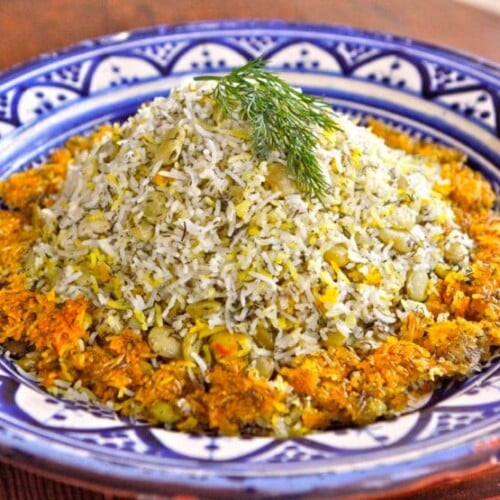
Persian Dill and Lima Bean Rice - Baghali Polo
Ingredients
- 3 cups white basmati rice
- 12 ounces frozen baby green lima beans or fresh young fava beans, shelled and steamed till tender (1 bag)
- 2 teaspoons salt
- 1/2 teaspoon saffron threads
- 3/4 cup vegetable oil (I use grapeseed)
- 1 cup fresh chopped dill, or more to taste
NOTES
Instructions
- Rinse and sort the rice for a minute in the colander with cold water. Pour the rice into a medium mixing bowl and cover it with 2 inches of cold water. Let the rice soak for 90 minutes.

- Drain the rice in a colander and rinse again with cold water, shake out the excess water. Rinse and dry the mixing bowl and set aside.

- Bring 3 cups of water to a boil in a 5 quart nonstick pot (using a pot with a nonstick surface is important; it will help in the formation of the crispy tahdig). Pour in the rice, beans, and salt. Stir. Bring the water back to a boil. Let the mixture boil uncovered on medium high for 8 minutes. Stir the rice periodically during cooking.

- While rice is boiling, crush the saffron threads in a mortar and pestle. Pour 1/2 cup of hot water into the mortar and let the saffron soak.

- After 8 minutes of boiling, pour the rice into a colander and rinse with lukewarm water, then drain. Rinse and dry the pot and put it back on the stove. Stir the fresh chopped dill into the rice in the colander, making sure it is well mixed throughout the rice. I use about 1 cup of chopped dill; you can use more if you like a very green rice with a strong dill flavor.

- In the medium mixing bowl, stir together 1/2 cup vegetable oil, half of the saffron water, and 1 1/2 cups of the cooked rice.

- Spread the oil and rice mixture in an even layer on the bottom of the pot. This will become your tahdig.

- Scoop the rest of the rice out of the colander and into the pot, forming a volcano-shaped mound in the middle of the pot.

- Make a hole in the center of the volcano with the handle of a wooden spoon, pushing it almost to the bottom of the pot.

- Place a thin kitchen towel over the top of the pot, being careful not to let the towel get too close to the heat source. Place the lid tightly over the top of the towel. Turn on the heat to medium and let the rice steam for 10 minutes.

- Meanwhile, mix together the remaining saffron water with remaining 1/4 cup of vegetable oil.

- After 10 minutes, remove the towel and lid from the pot and pour the saffron oil mixture evenly over the top of the rice.

- Replace the towel and lid. Turn heat to low. Let the mixture steam for 45-50 minutes longer.Move the pot to a cool surface and let it rest for 5 minutes. When ready to serve, you have two options.

- Option 1: Scoop the rice out of the pot and mound it onto a serving plate or tray, leaving a thin layer of rice undisturbed at the bottom of the pot.

- Use a spatula to loosen the crispy tahdeeg from the bottom of the pot and arrange the pieces around the cooked rice. Garnish with a little fresh dill, if desired.

- Option 2: Place a large serving plate upside down on top of the pot. Invert the pot quickly and gently unmold the rice from the pot. This will keep the tahdig intact and create a cake-like effect with the rice.

- Serve hot.

Nutrition

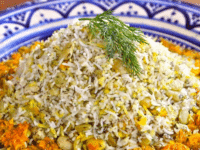

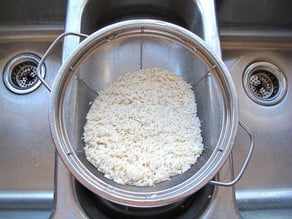
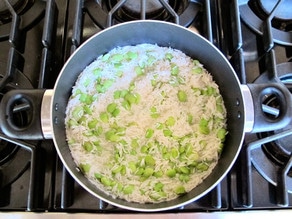
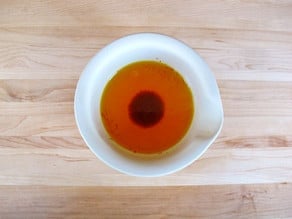
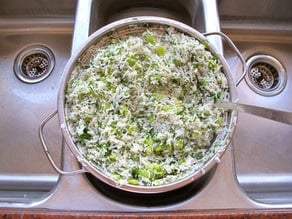
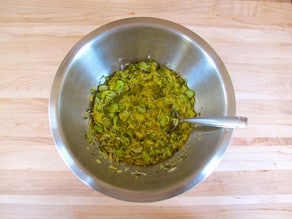
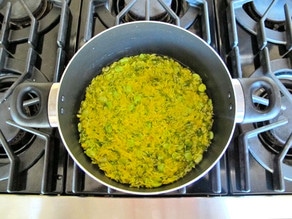
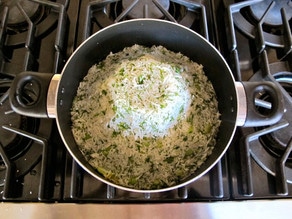
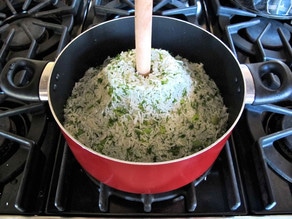
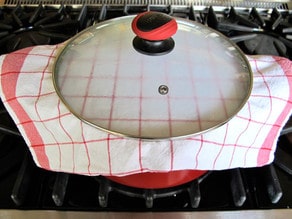
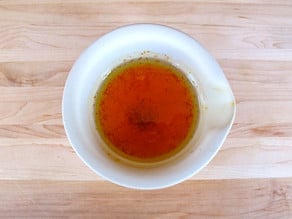
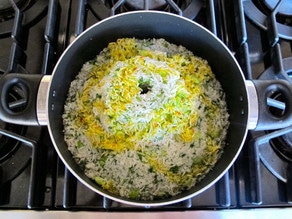
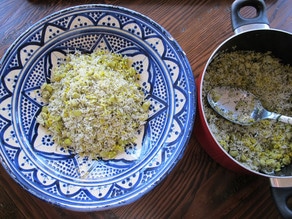
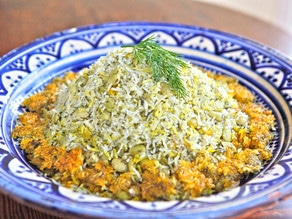
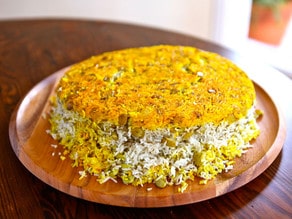
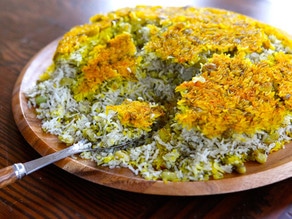


Thank you. I had this dish first in 1977 when my neighbors who were Iranian students made it. I loved it being I was s vegetarian. You’re recipe is simple and easy to make now that I am a vegan. This dish bring back wonderful memories. Thank you.
Thank you for sharing this recipe. I tried it for our non-traditional Thansgiving dinner 2021, Cornish Hens, homemade cranberry sauce, and this rice, the rice was perfect for the meal, and our family loved it. Thakn you again.
I used to always order Baghali Polo at a Persian restaurant in my hometown. They closed years ago, and I have been looking for Baghali Polo ever since. I could never find a Persian restaurant that served it, so I finally tried making it myself a few years ago. Of all of the recipes I’ve tried, yours is the best! I just added in garlic and other seasonings for more flavor, but your consistency and texture is perfect. Your precise explanations and helpful visuals make anyone who isn’t familiar cooking this way can easily do it. Thank you so much for sharing this recipe! 🙏🏽
Hi Tori,
My non stick pan was wide so tahdig was crispy but thin. I’ll need to buy a nonstick pot that is narrower and deeper.
Thanks for all the detailed tips. Rice so delicious and perfectly paired with halibut and beurre blanc sauce.
Thanks for this recipe Tori, My name is Loving just made it tonight and although it took a good while as there are many processes, it came out really well and I got a crispy bottom!
I’m original from the Dominican Republic My boyfriend is from Iran he asked to make him persian dill and lima bean rice. I have to give myself a thumb up ? is the most delicious rice I ever made!
Hi
I’m really excited to try this recipe. Is there any way to stop the video that starts playing every time I scroll down the page? I don’t mind watching an ad in exchange for a free recipe, but once I pause the video, it starts automatically every time I scroll down. It’s unbearable. I really wanna try this recipe, but I can’t look at the webpage long enough. Help!
Hi Jonny, that shouldn’t happen – it must be a glitch. Can you please tell me what browser you are using and if you are on desktop or mobile? I will look into it right away.
Am planning to try your recipe this weekend. Have made Baghali Polo before, and the Iraqi friend who taught me added finelynchopped onions. Have you heard if that Tori?
Hi Patti, I have never added onions to Baghali Polo and I don’t think I’ve ever eaten it this way before… it might be good, but I’m not sure where in the process it would be added or how it might affect the tahdig. Onions will burn if mixed into the tahdig so I would think they would need to be cooked/caramelized separately and then stirred into the rice before steaming. But not sure– you should ask your friend for their process. 🙂
My rice at the bottom isn’t crisping, it’s just oily and like the rest of the rice. What am I doing wrong?! Tastes delicious however!
Hi Alina, Tori’s assistant Ashley here! I would suggest trying a slightly higher heat level next time, but be careful. There’s a fine line between crispy and burned. Hope this helps!
Thanks for this recipe Tori, I just made it tonight and although it took a good while as there are many processes, it came out really well and I got myself a crispy bottom! It didn’t come out clean, we had to spatula it off, but everyone said they loved it! And my English-Iranian friend says my tahdig looked good in the pic I sent over 🙂 Which is a compliment indeed!
My older sister had a Persian roommate while in graduate school. After graduation she went to Iran and lived with her roommates family and taught English. She came home with amazing stories and exotic recipes that dazzled my teen eyes and senses. I have always loved her Persian cuisine. She and her husband found out in receent years he has kidney disease which requires less nutritious” (protein heavy) meals. After a lifetime of organic glorious nutrition and vegetable rich cooking – how to cook and still have flavor and enough calories to support his very active cycling and hiking. She made this while I was visiting last year and I still can close my eyes and remember the fresh garden dill and saffron. Curiously I lost 10 lbs while there but sat more and ate more than I do at home. I am G/F and D/F K Thanks so much for the recipe and pictures – now I can do it myself.
For the last steaming part, could i use a ricecooker? I live in a dormoom and don’t have a non stick pan hahaha.
Hi Yasmine! Yes you could, but you won’t end up with a crispy dahdig at the bottom. In fact, the bottom part where you mix the oil and saffron water will just by oily, most likely, so you’ll probably need to stir that part into the rice. I can’t be certain because I haven’t tried it with a rice cooker, but this is my guess.
I’ve been making tadigh with my rice for years without a non stick pot, it takes a little practice but you can do it. Use a good quality pot and some butter, it may stick a bit but you can get it out with a spoon without much effort. I grew up eating this dish and it’s wonderful. I skip the saffron but i use butter.
I actually made this in the rice cooker and it turned out perfectly! I got a nice crispy goldten tajdij at the bottom. However, I have the option to steam only at three differnent temperatures. So, if you can adjust the temp, and also get it to steam only not boil then it can work.